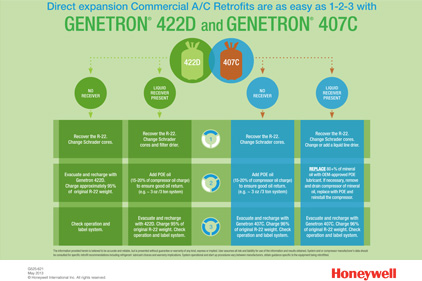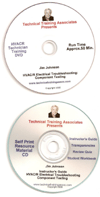EDITOR’S NOTE: Retrofitting HFC refrigerants into systems designed for HCFC-22 is gaining attention especially in refrigeration because that sector moved especially fast to R-22 when CFCs faced phaseout. This article from Honeywell is a detailed look at the retrofit procedures. While specifically related to the HFC refrigerants R-407C and R-422D, it gives contractors and service technicians a good idea of what’s involved in such retrofits. As with any retrofit procedures, contractors are encouraged to contact refrigerant and equipment manufacturers for guidance.
HCFC-22 is a high-capacity, efficient refrigerant employed in a significant number of air conditioning and refrigeration systems. The majority of these systems utilize mineral oil lubricants.
Due to the phaseout of HCFCs, facility owners are considering retrofitting their mechanical systems to alternative refrigerant blends. The selection of a retrofit fluid depends, in part, upon retrofit objectives that may include factors such as efficiency, first cost, global warming potential, and capacity. By following the equipment manufacturer’s recommendations and Honeywell’s guidelines outlined here, service technicians can readily retrofit many existing air conditioning systems to either Genetron® 407C (HFC-407C) or Genetron® 422D (HFC-422D).
Introduction
As the industry continues to move away from the use of HCFCs, refrigerant service personnel will play a key role in the transition to HFC alternatives through retrofitting. Honeywell has produced this guide to help service technicians better understand the various technical and operational aspects of carrying out retrofit procedures using Honeywell Genetron 407C and Genetron 422D.
Although this information can be helpful as a general guide, it should not be used as a substitute for the equipment manufacturer’s specific recommendations.
Also, retrofitting should be considered system specific. Since systems can differ in condition and configuration, retrofit actions applied to one system will not necessarily result in the same level of success in another system. For this reason, Honeywell strongly recommends contacting the equipment manufacturer for detailed information on retrofitting the specific model under consideration. Also, refer to the Material Safety Data Sheet (MSDS) for safety information on the specific Genetron refrigerant you will use. R-407C and R-422D are HFC refrigerants and are not scheduled for phaseout under current law.
R-407C and R-422D are HFC-based refrigerants that normally utilize synthetic lubricants.
The mass flow differences as well as the slightly different operating pressures should be evaluated. Check with the compressor manufacturer to determine if the existing lubricant is acceptable.
The retrofit procedures listed here have been developed by Honeywell to address these issues and to help technicians perform successful retrofits of HCFC-22 systems utilizing positive-displacement (reciprocating, rotary, and scroll) compressors.
Retrofit Procedure
In retrofitting an existing air conditioning system, material compatibility and the condition of the existing seals and gaskets must be taken into account. It is recommended to change any O-rings, seals, and other elastomers used in the system (as expected in any retrofit to HFC). In most air conditioning and heat pump systems this only applies to the Schrader valve seal and cap seal material.
Below are the 10 steps in retrofitting R-22 systems to R-407C or R-422D. (Click here for graphs highlighting residential and commercial a/c retrofits.)
1. Record baseline data.
Before making any hardware changes, compare current system operating data with normal operating data. Correct any deficiencies and record final data as a performance baseline. Data should include temperature and pressure measurements throughout the system including the evaporator, compressor suction and discharge, condenser, and expansion device. These measurements will be useful when adjusting the system with an alternative refrigerant.
2. Isolate R-22 refrigerant charge.
The HCFC refrigerant charge should be removed from the system using an approved recovery machine capable of meeting or exceeding the required levels of evacuation.
The charge must be collected in a recovery cylinder. Do not vent the refrigerant. Knowing the recommended R-22 refrigerant charge size for the system is helpful. If it is not known, weigh the entire amount of refrigerant removed. This amount can be used as a guide for the initial quantity of alternative refrigerant to be charged to the system.
3. Choose the compressor lubricant.
In most instances, the lubricant in use with R-22 is a mineral oil or alkyl benzene. Polyolester lubricants are recommended for use with R-407C by the equipment manufacturers. R-422D retrofit of a system with short connecting lines typically will not require an oil change or modification. Honeywell recommends using a miscible lubricant approved by the compressor manufacturer. In this case, POE oil is recommended for R-422D. Differences among lubricants make it difficult to assume that they are interchangeable.
Check with the compressor manufacturer for the correct viscosity grade and brand for the compressor in the system being retrofitted. If the lubricant is contaminated or an acid test indicates high levels of acidity, then a lubricant change is warranted.
Field trials have indicated that adequate oil return can occur in HFC retrofit systems when 15 to 20 percent of the lubricant operating charge is synthetic oil. Systems with receivers or low-side accumulators (heat pumps) will require a higher ratio of POE to mineral oil.
4. Evaluate the expansion device.
Honeywell recommends consulting with the equipment manufacturer before retrofitting. Most HCFC-22 a/c systems with either expansion valves or capillary tubes will operate satisfactorily with 407C or 422D.
5. Replace the filter drier.
Following system maintenance, a recommended service practice is to replace the filter drier. There are two types of filter driers commonly used in refrigeration equipment: loose-fill and solid-core.
Check with your wholesaler to make sure the replacement filter drier is compatible with the refrigerant being used.
When changing to an HFC-miscible lubricant, particularly to a more polar lubricant such as polyolester, it may be beneficial to add a suction line filter.
6. Reconnect the system and evacuate.
Use normal service practices to reconnect and evacuate the system. To remove air and other noncondensables, Honeywell recommends evacuating the system to a full vacuum of 1,000 microns or less from both sides of the system. However, attempting to evacuate a system with the pump connected only to the low-side of the system will not adequately remove moisture and noncondensables such as air. Use a good electronic gauge to measure the vacuum. An accurate reading cannot be made with a refrigeration gauge.
7. Check the system for leaks.
Check the system for leaks using normal service practices.
8. Charge the system with Genetron HFC refrigerant.
When replacing HCFC-22 with 407C or 422D, use the same charging procedures that you would use for the refrigerant being replaced. When working with 407C or 422D, it is important to remember that these are blend refrigerants. It is essential that blend refrigerants be charged by removing only liquid from the cylinder.
A throttling valve should be used to control the flow of refrigerant to the suction side to ensure that the liquid is converted to vapor prior to entering the system.
NOTE: To prevent compressor damage, do not charge liquid into the suction line of the unit. Never vapor charge the system with vapor from a 400 series refrigerant cylinder. Vapor-charging may result in the wrong refrigerant composition and could damage the system.
Systems being charged with 407C or 422D require a slightly smaller charge size than R-22.
For expansion valves or optimized capillary tube systems, the typical charge size relative to the HCFC-22 being replaced is 4 to 5 percent less for 407C and 422D than the 100 percent charge size for R-22.
As part of general procedure, Honeywell recommends initially charging the system with 85 percent by weight of the original system charge and then adding refrigerant as necessary in 5 percent increments to obtain equal baseline performance.
9. Check the system operation.
Start the system and allow conditions to stabilize. If the system is undercharged, add refrigerant in increments of 5 percent by weight of the original charge. Continue until desired operating conditions are achieved.
It may be necessary to reset the pressure cutouts to compensate for the different pressures of the replacement refrigerant. This procedure should be done carefully to avoid exceeding the recommended operating limits of the compressor and other system components. The use of an unoptimized capillary tube will make the system more sensitive to charge and/or operating conditions. As a result, system performance will change more quickly if the system is overcharged (or undercharged). To avoid overcharging, it is best to charge the system by first measuring the operating conditions (including discharge and suction pressures, suction line temperature, compressor amps, and superheat) instead of using the liquid line sight glass as a guide.
For blend refrigerants, pressure-temperature data will include bubble pressure and dew pressure data. To determine superheat, use the dew pressure column. To determine subcooling, use the bubble pressure column. To find average evaporating or condensing temperature, find the measured pressure in both the bubble and dew columns and take the average of the two corresponding temperatures.
10. Label components and system.
After retrofitting the system with 407C or 422D, label the system components to identify the specific refrigerant and specify the type of lubricant (by brand name) in the system. This will help ensure that the proper refrigerant and lubricant will be used to service the equipment in the future. Unit Charge labels are available through Genetron wholesalers.
SIDEBAR: Safety Tips
1. Never mix refrigerants in a refrigeration system or recovery cylinder. Any refrigerant mixing creates a nonreclaimable mixture that will cost you or your customer more money in disposal fees.
2. Never leak-test a system using air, oxygen, or other oxidizing materials. When combined with HFCs and HFC/hydrocarbon blends under pressure, these mixtures can become combustible.
3. Always read the label and Material Safety Data Sheet (MSDS) before working with the refrigerant(s).
4. Never top off a system with a refrigerant other than what is already in that system. If you aren’t sure what’s in a system, either recover the full charge or have the refrigerant tested.
5. Always make sure systems you work on are properly labeled with the refrigerant and oil when you leave.
6. Do not store refrigerant cylinders in direct sunlight or in areas where temperatures could exceed 125°F.
7. Keep smaller cylinders from becoming a rolling hazard by keeping them in their cartons while storing or transporting them.
8. Always recover the contents of nonrefillable refrigerant cylinders to 0 psig or less before disposing of them. Whenever possible, recycle nonrefillable cylinders at a local metal recycling center or scrap yard.
For more information, go to www.honeywell-refrigerants.com.








